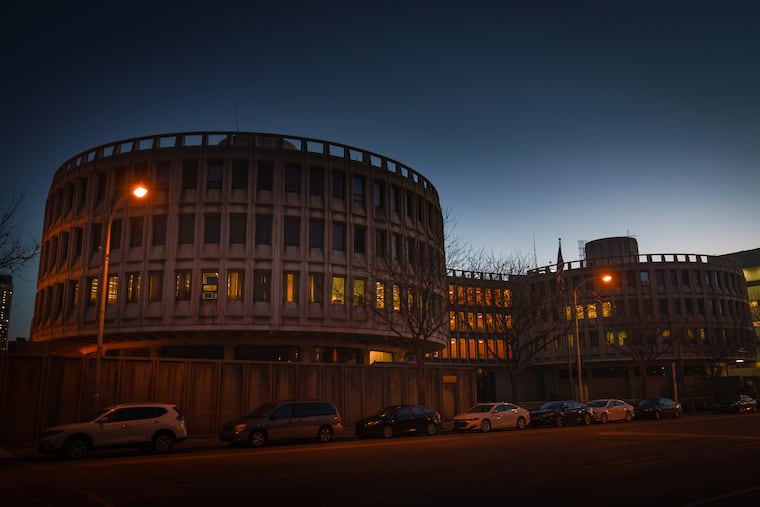The Roundhouse’s architect debunks a Philly urban legend: The building wasn’t designed to look like handcuffs
Robert Geddes wants to see Philly's former police headquarters return to its original, modernizing and progressive vision.

As the City of Philadelphia ponders what to do with its former police headquarters, popularly known as the Roundhouse, many people are being asked to weigh in.
The community outreach process for the future of the elegant and imposing midcentury concrete structure will take place in neighborhoods throughout the city. Consultants are interviewing police officers, those who were detained in the building, and other stakeholders.
They are also talking with Robert Geddes, an architect who designed the building, which opened in 1962, while he worked at his Philadelphia-based firm, Geddes Brecher Qualls & Cunningham.
To begin with, he’s a little annoyed with the nickname that’s almost become the official title for his Police Administration Building.
“I, personally, am not interested in naming a building by its shape in Philadelphia or elsewhere,” said Geddes, who will turn 99 this December. “What would you call the Empire State Building? The giant tower?”
Relatedly, he says that the widely held belief that the building is meant to resemble handcuffs is false and “silly.” The Roundhouse’s distinctive shape was designed to accommodate three elevator shafts, one in the center for what was meant to be an entrance for the public and the two others in the wings of the building for the exclusive use of the Police Department.
That vision became obsolete later in the 1960s when the front entrance on Race Street was closed to the public. Similarly, the wall that encircles the building, giving it a fortresslike atmosphere, was not in the original designs. The department added it later, shortly after construction was completed.
Geddes says changes like that have contributed to a misunderstanding of his building, and its original intent.
» READ MORE: What should Philly do with the Roundhouse? No, seriously, the city is asking for your help.
How the Roundhouse was conceived
Prior to the Roundhouse’s opening in 1962, police were headquartered in City Hall. A progressive mayor in the 1950s, Richardson Dilworth, wanted to professionalize and de-politicize the department by giving it a state-of-the-art building to symbolize its independence from patronage politics.
“The city had many conventional buildings, but none that really stood out as an emblem of modernity,” remembers Geddes. “Dilworth wanted that.”
Geddes and his partners were selected partly because the firm’s work had a reputation for being modern, progressive, and young – just the kind of adjectives Dilworth wanted to be associated with.
The monumental concrete design of the Roundhouse was part of a trend of midcentury municipal buildings that, at the time, were considered fashionable and even visionary. An unprecedented 90% of it is made of precast concrete, produced by an innovative Dutch method used in high-quality architectural projects.
In the 1950s and 1960s, buildings like the Roundhouse were seen as forward-thinking incarnations of postwar liberalism.
A 1963 article about the Roundhouse in Architectural Forum praised the “conviction that headquarters should be anything but a grim forbidding fortress, scaring the wits out of the citizenry. ... This is the first major building to match the fresh thinking of Philadelphia’s planners with equally fresh thinking about architecture.”
‘Rizzo hated the building’
But the ideals that inspired the creation of the Roundhouse, and the liberal administrations that commissioned it, were supplanted by the tumultuous political events of the 1960s.
The backlash against the reformers and the growing power of the Black community, as well as spiking crime, led to the rise of police commissioner, and then mayor, Frank Rizzo. While Dilworth was known for his progressive ideals, Rizzo was just the opposite. His flamboyantly hard-charging tactics stirred controversy, especially in the Black neighborhoods that bore the brunt of both heavy-handed policing and violent crime.
“I know Rizzo hated the building,” said Geddes. “What was done in that basement, and on the streets, is horrible to contemplate. I can’t account for hatred. But the building didn’t cause it, although it certainly suffered and is suffering from that legacy.”
The Roundhouse’s future
Now as the future of the building is in question, and the possibility of demolition looms, it is that troubled legacy that may imperil the Roundhouse. There are many Philadelphians who associate it with fear and oppression, even as for others it symbolizes authority and safety. For some, it’s a complicated mix of both.
“When I was growing up, [I was told] you don’t want nothing to do with the Roundhouse: That’s the police, that’s trouble,” said Luz Crespo, a resident of North Philadelphia who attended the first public meeting on the building’s future. “I have a brother and sister who gave the police 40 years, so I respect authority a lot.”
Geddes hopes the building can be put to use as offices for human rights organizations or groups that serve the Black community. On the ground floor, he thinks restaurants would be a natural fit, especially with Chinatown so close by.
“The building is really quite well-known internationally,” said Geddes. “People all over the world would be surprised, shocked, if it were torn down. The simplest thing to do is to find a developer who would open up the ground floor and use the offices for institutions concerned with human well-being.”
Future events and online engagement for community input can be found at Framing the Future of the Roundhouse.